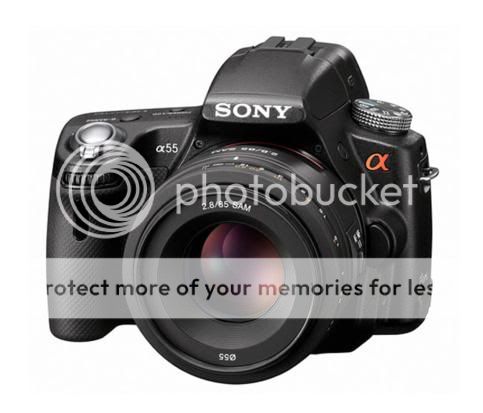Hamish Gill
Tech Support (and Marketing)
Sony have recently announced the new Translucent Mirror Technology Digital cameras

it certainly looks like an interesting idea, and i for one think sony should be congratulated for continuing to be inventive.... although i do slightly feel they are re-inventing the wheel.... but...im not one to speculate on how well this will work, so i will endeavour to let you know as soon as i get my hands on one ... dpreview has already reviewed it here http://www.dpreview.co.uk/news/1008/10082422sonyslta55review.asp
Press Release:

it certainly looks like an interesting idea, and i for one think sony should be congratulated for continuing to be inventive.... although i do slightly feel they are re-inventing the wheel.... but...im not one to speculate on how well this will work, so i will endeavour to let you know as soon as i get my hands on one ... dpreview has already reviewed it here http://www.dpreview.co.uk/news/1008/10082422sonyslta55review.asp
Press Release:
Light, compact α55 and α33: up to 10fps shooting with high-speed AF tracking and Full HD movie
α55 (SLT-A55V) (16.2 megapixels) and α33 (SLT-A33) (14.2 megapixels)
Ultra-quick shooting up to 10fps with fast, precision phase detection AF
First ever Quick AF HD Movie with smooth, continuous autofocus during video shooting
Enhanced Quick AF Live View and 7.5 cm (3") free-angle LCD, plus Tru-Finder (Electronic Viewfinder) with 100% coverage
Advanced imaging functions including 3D Sweep Panorama, Auto HDR and multi-frame noise reduction
The α (pronounced Alpha) family of interchangeable lens cameras from Sony grows with the compact, ultra-responsive new α55 and α33.
Sony’s first-ever digital cameras to employ Translucent Mirror Technology showcase an innovative optical system that opens up dramatic new shooting possibilities. In contrast with conventional DSLR cameras, Translucent Mirror Technology uses a fixed, translucent mirror that ‘splits’ the optical pathway between the main image sensor and a separate phase-detection autofocus sensor.
High-resolution live image preview with rapid, accurate phase detection autofocus is thus available at all times – either via the angle-adjustable 7.5cm (3”) LCD or precision Tru-Finder (electronic viewfinder). This also ensures that even moving objects stay in sharp focus at all times, whether you’re shooting Full HD video or stills.
Translucent Mirror Technology overcomes other traditional limitations of DSLR models, with its simplified mechanical design shrinking camera size and complexity. This makes the α55 and α33 a compelling choice for casual photographers who want to capture spontaneous family moments and travel scenes with less to carry.
Full-resolution shooting at up to 10fps with precise AF tracking
Ground-breaking Translucent Mirror Technology allows high-speed shooting with the α55 at up to 10fps (α33: 7fps) in Continuous Priority AE mode. This represents the world’s fastest burst continuous AF shooting performance of any interchangeable lens camera with an APS-C size sensor.
A newly developed 15-point phase-detection autofocus system assures rapid, accurate AF tracking, keeping even moving subjects in sharp focus during continuous shooting. This enables the α55 and α33 to capture split-second action or fleeting nuances of expression with portrait subjects.
World’s first Quick AF Full HD movie shooting
The large sensor size Exmor™ APS HD CMOS Sensor inside both cameras lets photographers capture stunning, cinematic HD video footage with beautiful background defocus (bokeh) effects.
Theα55 and α33 also mark the debut of Quick AF Full HD movie shooting. Translucent Mirror Technology enables AVCHD 1080i video shooting with smooth, precise phase detection AF tracking of moving subjects. Real-time video image preview is now possible via the viewfinder – in contrast with DSLR cameras where the raised mirror prevents light from reaching the optical viewfinder during video shooting.
Effortless composition and image viewing
Theα55 and α33 enable exciting new possibilities for framing and viewing highest-quality video and still images. Already prized by step-up DSLR users and enthusiasts alike, Sony’s Quick AF Live View system is now more effective than ever. High-resolution live image preview is teamed with uncompromised phase detection AF performance – even with rapidly-moving subjects.
Tilting and swivelling freely (to maximum 270 degrees) for comfortable framing at any shooting angle, the bright 7.5 cm (3.0") (16:9) Xtra Fine LCD offers superb detail and contrast.
There’s also a precision electronic viewfinder with 1.15 million dot resolution that delivers a clear, bright image with 100% frame coverage. Adjustments to exposure, depth of field and colour can be previewed instantly, either in the viewfinder or on the LCD. Effortless composition is aided further by switchable grid line in the finder and LCD screen, plus a new digital levelling gauge.
Enriched creative possibilities
Theα55 and α33 are compatible with the full range of over 30 A-mount interchangeable lenses and offer SteadyShot INSIDE. This in-body image stabilisation system provides up to 4 exposure steps of anti-shake correction when shooting handheld.
Both cameras also feature 3D Sweep Panorama, allowing photographers to capture detail-packed extra-wide panoramas with a huge field of view. 3D panoramas can be enjoyed on any compatible 3D HD television. The SLT-A55 is also the first α camera by Sony with integrated GPS, allowing automatic geo-tagging of images and video clips.
The new-generation Exmor™ APS HD CMOS Sensor inside both cameras supports a sophisticated range of digital image compositing and processing functions. This gives even greater artistic possibilities to beginners and photo enthusiasts alike.
Auto HDR is now refined further compared with previous-generation α models. Data from a burst of three frames at bracketed exposure values is automatically combined, creating a single image with extended highlight and shadow detail Multi-frame Noise Reduction ‘stacks’ a high-speed burst of six frames, creating a single low-noise exposure that boosts effective sensitivity as high as ISO 25600.
The new cameras accept both Memory Stick PRO Duo™ (including Memory Stick PRO-HG Duo™) and SD (including both SDHC and SDXC formats) media (all sold separately). Memory Stick PRO-HG Duo HX 30MB per second transfer rate offers the best performance during cameras' continuous shooting mode or when transferring the data to another media.
The new α55 and α33 Single Lens Translucent mirror cameras by Sony are available from September 2010.

